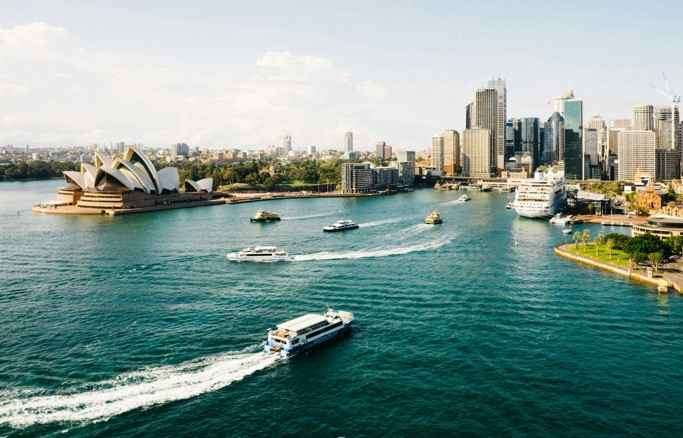- Home
- Blog
- Write for Us
- Travel Shop
- Type of TripsSolo Female TravelGirls Trip DestinationsAdventureBudget TravelLuxury TravelSolo Female TravelGirls Trip DestinationsAdventureBudget TravelLuxury Travel
- Resources

Australia is a dream destination for many individuals. It offers various educational opportunities, along with a diverse culture and breathtaking landscapes.
If you are thinking about moving to Australia, you must know the cost of living there. The cost of living in Australia is more expensive as compared to other countries. The cost depends on things like the city you live in, your lifestyle choices, and other factors.
In this article, we will explore the cost of living in Australia, covering various aspects such as accommodation, transportation, groceries, medical expenses, utility costs, and educational costs. We will also provide tips on how to reduce expenses and save money while living in Australia.
Table of Contents
The cost of living in Australia can vary depending on the city and lifestyle preferences. Here is an overview of some living expenses in Australia:
The average rent in Australia varies depending on factors such as the type of accommodation (apartment, house, or shared rental) and its location.
The following are the average monthly costs of groceries in Australia.
| Type of Accommodation | Average monthly rent |
| Homestays | $450-$1,200 |
| Halls of residence | $440-$1,100 |
| Apartment | $750-$1,700 |
| Shared apartment | $850-$850 |
| Campus Accommodation | $110-$280 |
The cost of transportation in Australia can differ depending on factors such as your location, the mode of travel, the discounts available, and your personal choices. For travelers on a budget, exploring discounted options and considering alternative modes of transportation can significantly impact overall expenses.
The following are the average monthly costs of groceries in Australia.
| Type of Expense | Cost in (AUD) |
| Local transport ticket | $2 to 6 for two ways |
| Taxi | $3.60-7 |
| Fuel | $1.81 to $1.95 per litre |
The cost of groceries in Australia can differ depending on different factors, such as store choice, region, and individual buying patterns.
The following are the average monthly costs of groceries in Australia.
| Food Expenses | Cost in (AUD) |
| Fruits and vegetables | $80-$160 |
| Drinks | $40 – $80 |
| Pantry Staples | $80 – $120 |
In Australia, there are two types of healthcare services: public and private.
Public healthcare is free or cheaper, but you might need to pay a small fee for some treatments. Private healthcare is available through insurance and gives you more choices and coverage for treatment. However, the cost of medical checkup also depends on factors like type of checkup, location and others.
The following are the average monthly costs of a medical check-up in Australia:
| Medical Expenses | Cost in (AUD) |
| Medications | $7-30 |
| Doctor’s consultation fee | $30 – $80 |
| Dental costs | $50 – $150 |
Utility expenses cover things like electricity, water, gas, and the Internet. The total amount you spend on utilities depends on factors such as location, and size.
The following are the average utility costs in Australia.
| Types of Utility Costs | Cost in (AUD) |
| Internet for single a person | $60-95 per month |
| Electricity | $80 -$90 per month |
| Gas | $55 per month |
| Water | $50-$80 per month |
| Telephone bill | $35 per month |
The cost of education in Australia can differ based on the universities and the degree you’re pursuing. Additionally, it depends on whether you live in a metro area or a regional area, as institution costs in cities are usually higher than in regional or remote areas. As per experts from CDR Australia, understanding these factors can help students make informed decisions about their educational choices and financial planning.
The following are the average educational costs in Australia.
| Education Costs | Cost in (AUD) |
| Bachelor’s degree
|
$15,000 – $40,000 per year |
| Master’s Degree | $20000 – $50,000 per year |
| Doctoral Degree (PHD) | $14,000 – $37,000 |
The average estimated cost for an individual in Australia is as follows:
| Categories | Sydney | Melbourne | Brisbane | Perth | Adelaide |
| Accommodation Cost Monthly | AUD $2,000 – $2,500 | AUD $1000 -$3000 | AUD$1,600 – $2,300 | AUD $1,200 – $2,200 | AUD $1,000- $1,800 |
| Transportation Cost Monthly | AUD $200- $600 | AUD $200- $720 | AUD $160 – $480 | AUD $200 to $520 | AUD $160 to $400 |
| Groceries Cost | AUD $373 – $800 | AUD $408- $724 | AUD $320 – $650 | AUD $350- $700 | AUD $340 – $620 |
| Utility Cost | AUD $180 – $310 | AUD $150 – $300 | AUD $160 -$280 | AUD $170 -$290 | AUD $140 -$250 |
| Educational Costs (Bachelor, master and PhD) yearly | AUD $22,000-$120,000 | AUD $24,320- $94,944 | AUD $15,000 to $50,000 | AUD $20,000 to $50,000 | AUD $18,480 to $50,000 |
By applying the following tips you can easily reduce expenses and save money in Australia:
Creating a budget is a great way to save money and reduce your living expenses. It helps you keep track of how much money you earn and spend. It also helps to find areas where you can spend less, and make sure you’re not spending more than you have. You can use online tools or apps to make a budget easily.
Healthcare in Australia can be expensive, but there are many ways you can save money on healthcare. First, join a health fund, which can help cover all your medical expenses. Additionally, visiting public hospitals and clinics for treatment is more affordable than going to private ones.
Moreover, you can also try to stay healthy by getting regular check-ups and tests to catch problems early. Eating well and staying active can also contribute to your overall health and help you save money on medical bills in the future.
In Australia, driving your own car is more expensive than public transportation because of the fuel costs, insurance, etc.
To save money on transportation in Australia, you can use public transport like buses and trains. Public transport services provide discounts for certain groups, including students and seniors.
You can also choose to walk or ride a bike instead of using public transportation. This can help you save money while also being environmentally friendly.
Another way to reduce the cost of living in Australia is to choose affordable accommodations. Try living in a smaller or less expensive apartment to reduce expenses. Also, you may either move to an affordable area, or share accommodation with friends, which can help you save money.
Going to restaurants is expensive, so making food at home helps you save money. You can find various recipes on the internet that help you make delicious dishes at home. When you cook at home, you can also choose what goes into your food and how much you make, which helps you save even more. Plan meals ahead to avoid impulse buying and reduce food waste. Purchase non-perishable items in bulk to save money. Look for discounts, use coupons, and shop during sales. Start a small garden for herbs, vegetables, and fruits.
Managing personal finance effectively involves several key strategies. Start by creating and sticking to a budget to manage your expenses systematically. Automate your savings by setting up automatic transfers to a savings account, ensuring consistent growth of your savings without the need for constant manual intervention. Additionally, take advantage of cashback offers and reward programs to get the most value out of your purchases. Regularly review your subscriptions and cancel any that you don’t use to avoid unnecessary expenses.
Efficiently managing utilities can lead to substantial savings. Start by comparing providers for electricity, gas, and internet to ensure you’re getting the best rates. Take advantage of off-peak electricity rates by scheduling tasks like laundry and dishwashing during those times. Additionally, invest in water-saving devices such as showerheads and dual-flush toilets to reduce water consumption and lower your bills over time. These simple adjustments can make a significant difference in your utility expenses while promoting sustainability.
The Cost of living in Australia can be expensive compared to other countries because of factors such as high wages and the overall cost of living. However, by implementing certain strategies, it is possible to manage expenses and save money. Creating a budget and tracking your expenses can help you identify areas where you can reduce spending.
Additionally, choosing affordable accommodations, preparing meals at home, and finding ways to save on transportation and healthcare costs can contribute to significant savings over time. Exploring the best things to do in Australia can also provide opportunities for entertainment and enjoyment without breaking the bank. With careful planning and budgeting, individuals can enjoy the benefits of living in Australia while effectively managing their financial resources.
1. Is Australia Cheaper to Live in Than The US?
No, the cost of living in Australia is higher than in the US. Mainly cities like Sydney and Melbourne.
2. Why is The Cost of Living so High in Australia?
The cost of living in Australia is high because of factors like high wages, expensive housing, and a robust economy.
3. How Much Does Childcare Cost in Australia?
Childcare costs in Australia can vary depending on factors such as location and type of childcare. But on average, it ranges from $70 to $200 per day.
4. Is Australia Education Free for Children?
In Australia, public education isn’t totally free, but the government helps a lot with costs, so fees are lower. Private schools usually have high fees.
5. Is a Bus Cheaper Than a Train in Sydney?
For short rides in Sydney, buses are usually cheaper than trains. However, if you’re going a long way or it’s rush hour, trains might save you more money.
Written By – Grace Walker
What: This article covers the cost of living in Australia, including expenses like accommodation, transportation, groceries, healthcare, utilities, and education.
Why: Help the readers who are considering moving to or already living in Australia by providing useful tips and advice on managing money wisely and making good financial decisions.


Hi, Jill Here
Hi! I’m Jill, a Dallas, Texas girl traveling the world. After a career in the Air Force and touring over 50 countries later, my need to explore keeps going! It’s time to rock & roll and find all those places I never knew I was missing.
Table of Contents
Join me to get exclusive travel tips, giveaways and more!
Gallery
Copyright © 2023 | All Right Reserved